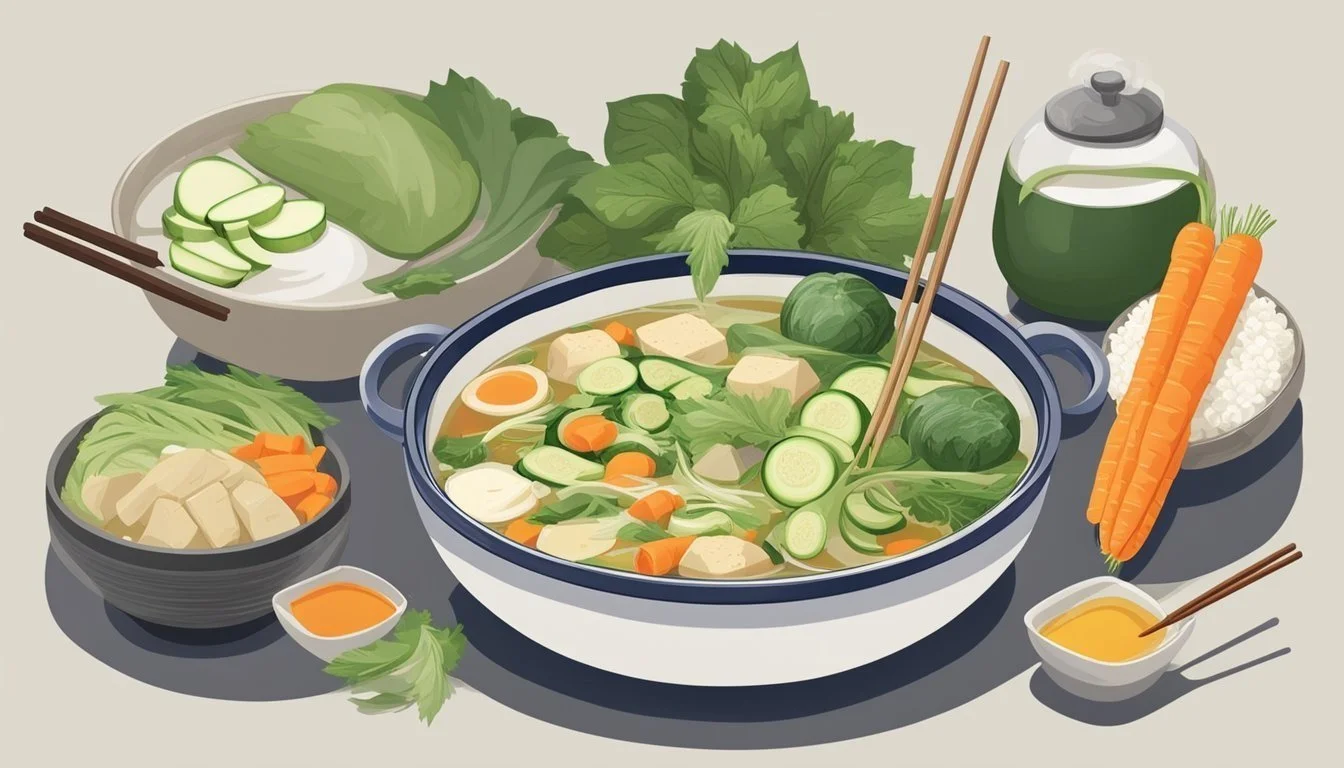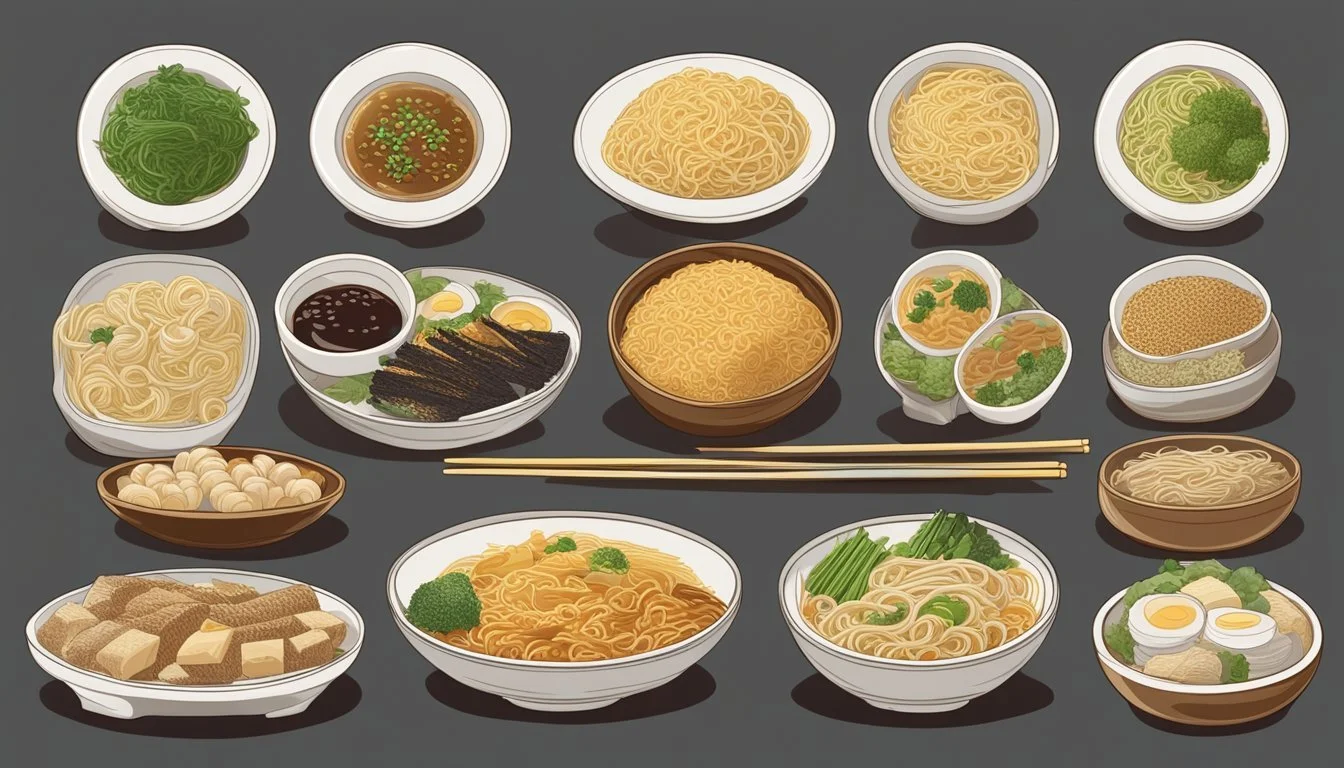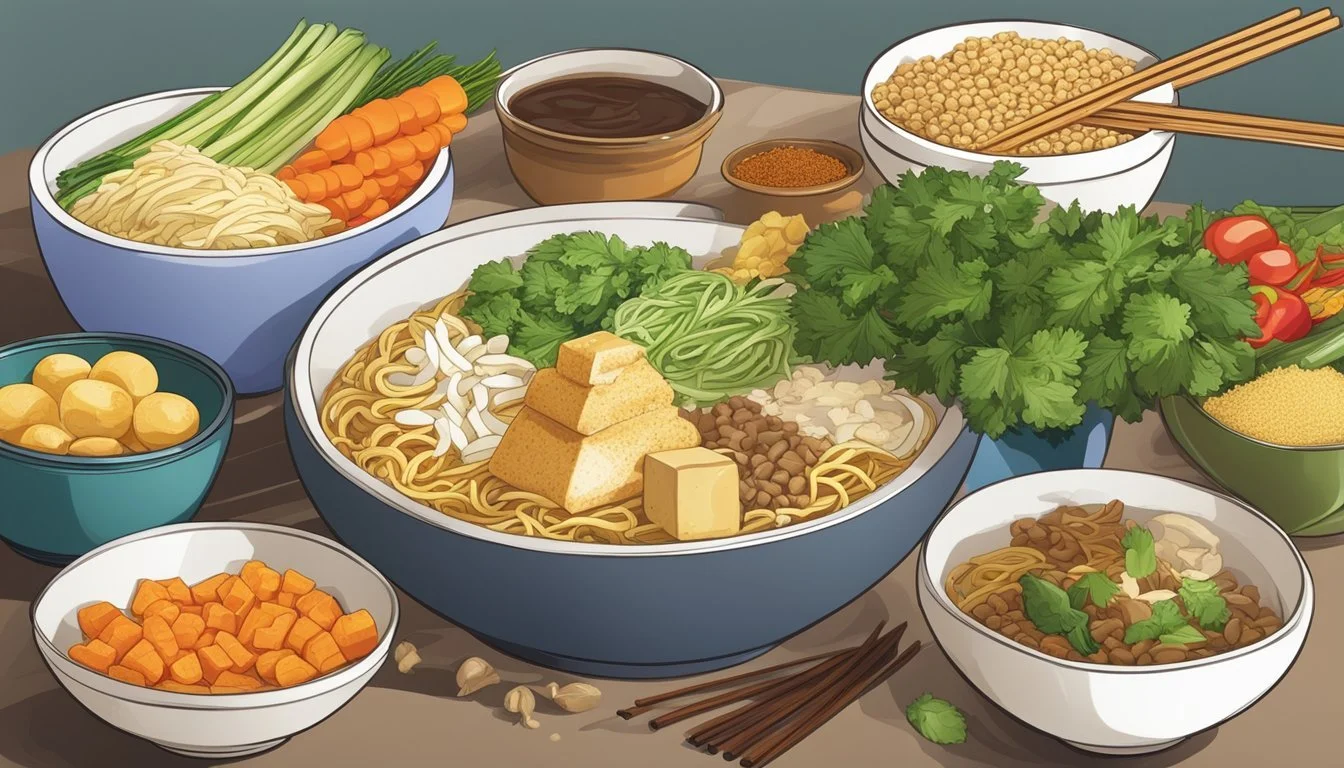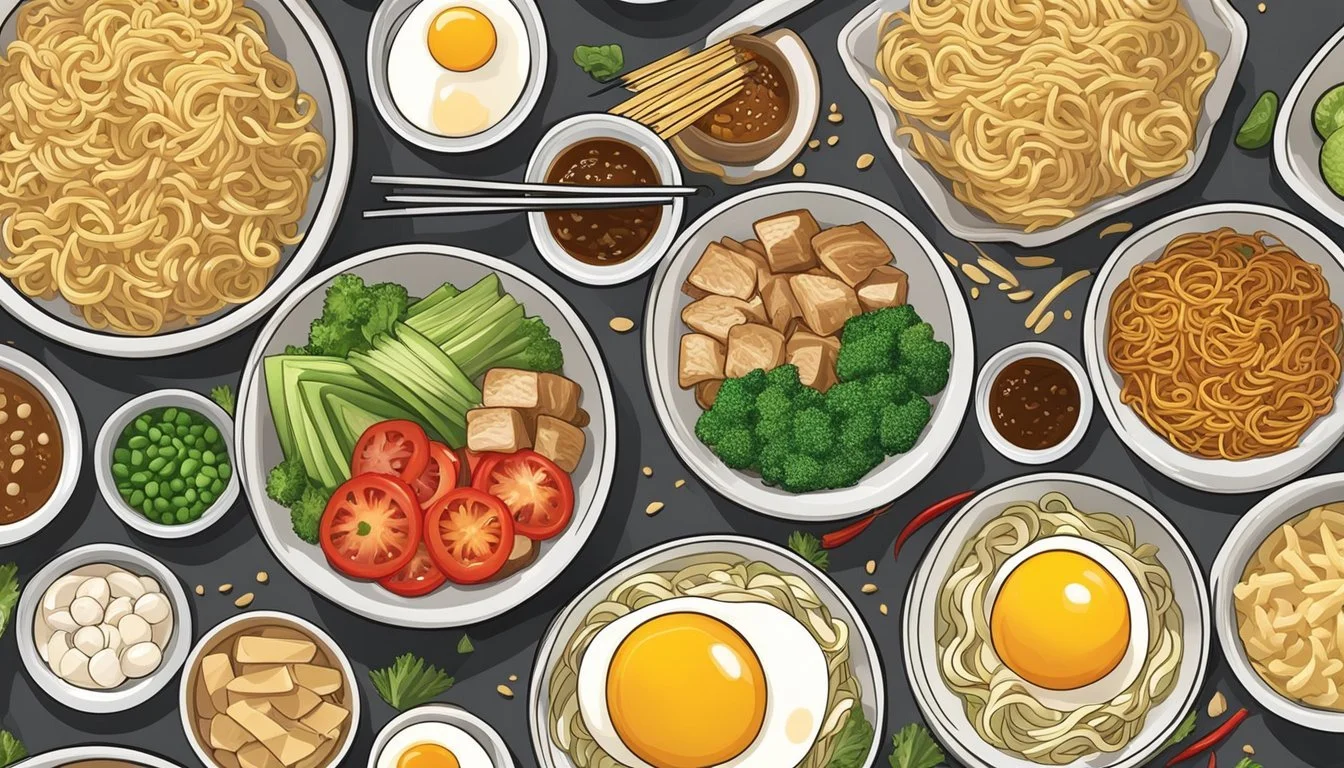Ramen Noodles Substitutes
Top Alternatives for Healthy Eating
Ramen noodles have become a global staple, adored for their swift cooking time, versatility, and rich flavor. However, dietary preferences, health considerations, or simply the desire for variety may lead individuals to seek out alternatives. A range of substitutes exists to satisfy the cravings for this beloved dish without compromising on taste or texture.
Several suitable replacements cater to different dietary needs, from gluten-free options to those rich in nutrients. Soba noodles made from buckwheat offer a similar bite to ramen and boast a robust nutritional profile, while rice noodles provide a light and gluten-free alternative that pairs well with traditional ramen seasonings and broths. Other variants such as shirataki noodles, made from konjac yam, provide a low-calorie option and kelp noodles bring a unique texture along with added minerals.
Choosing the right substitute can depend on the desired outcome of the dish. Glass noodles, for instance, can bring a translucent aesthetic and slippery texture, while heartier options like Chinese egg noodles or udon can mimic the thickness and chewiness of ramen noodles. With myriad options available, finding a suitable ramen noodle substitute can be an effortless and enjoyable endeavor.
Ramen Noodle Basics
Ramen noodles are a staple of Japanese cuisine, known for their unique texture and the flavorful broth they're often served in.
Ingredients and Texture
Ramen noodles are traditionally made from four simple ingredients: wheat flour, water, salt, and kansui—a type of alkaline mineral water. The presence of kansui is what gives ramen noodles their distinct yellow hue and springy, elastic texture. This firmness allows the noodles to hold up well in hot broth without becoming too soft too quickly.
Traditional Broth Flavors
The broth accompanying ramen noodles typically comes in a few traditional flavors:
Shoyu: A soy sauce-based broth that offers a salty, umami flavor profile.
Miso: Made with fermented soybean paste, contributing a rich, savory taste.
Tonkotsu: A pork bone broth that is creamy and full-bodied, often simmering for hours to extract deep flavors.
Shio: A lighter, salt-based broth intended to complement rather than overpower the noodles.
These broths are carefully prepared to enhance the natural wheat flavor of the noodles and to balance well with the texture, creating a harmonious dish.
Healthier Ramen Alternatives
When seeking healthier alternatives to traditional ramen noodles, it's important to consider gluten-free options for those with sensitivities or celiac disease, and lower calorie choices to align with weight management goals. These alternatives often possess additional health benefits such as increased fiber content and a better overall nutrient profile.
Gluten-Free Choices
Soba noodles are a popular gluten-free substitute made from buckwheat. Despite its name, buckwheat is not a wheat derivative and is safe for those with gluten intolerance. They provide a robust profile of minerals and are rich in fiber, aiding digestion.
Gluten-Free Substitute Key Nutrient Soba Noodles Fiber-rich, minerals Rice Noodles Easy to digest, gluten-free Kelp Noodles Low in calories, mineral-rich
Another excellent choice is rice noodles, which are inherently gluten-free and offer a light option that doesn't compromise on texture. Kelp noodles, made from seaweed, are an innovative alternative boasting a very low-calorie count while still delivering essential minerals.
Lower Calorie Options
For those seeking to reduce their calorie intake, shirataki noodles stand out as a remarkable option. They are virtually calorie-free, making them an attractive choice for weight loss diets. These noodles also contain glucomannan fiber which can support cholesterol and blood sugar levels.
Lower Calorie Substitute Key Nutrient Shirataki Noodles Glucomannan fiber, low-cal Kelp Noodles Iodine, low-cal Veggie Noodles Vitamins, low-cal, fiber-rich
Veggie noodles, spirals made from vegetables like zucchini or carrots, also offer a lower calorie alternative. They contribute a dose of vitamins and can increase the fiber and protein content of a meal, depending on the vegetables used.
Ramen Noodle Substitutes
Ramen noodles, a staple in many cuisines, can be replaced with various alternatives that cater to different dietary needs and flavor profiles. These substitutes include wheat-based noodles, other grains like rice, and even vegetable-based options.
Wheat-Based Alternatives
Chinese Egg Noodles: Similar in texture to ramen, they are made from wheat flour and eggs, making them an easy substitute in most dishes requiring ramen. Spaghetti, although traditionally Italian, can be a stand-in for ramen due to its comparable thickness and wheat composition.
Udon Noodles: Thicker than ramen, these noodles provide a chewy texture and are suitable for a variety of dishes.
Wonton Noodles: They are thin and can be used not only in soups but also in various Asian-inspired recipes.
Rice and Other Grain Noodles
Rice Noodles: Made from rice flour and water, they come in different thicknesses and can be a good gluten-free option.
Soba (Buckwheat Noodles): These have a nutty flavor, are high in protein, and can work well in both hot and cold dishes. Great for those looking for a nutritious alternative to ramen.
Glass Noodles: Made from starch, such as mung bean or potato, these noodles are transparent and absorb flavors well.
Vegetable-Based Substitutes
Shirataki Noodles: Composed mostly of water and glucomannan, a fiber from the konjac root, shirataki are low-calorie and carbohydrate-free. Their texture is distinct but they're versatile for many dishes.
Veggie Noodles: Spiralized vegetables such as sweet potato or zucchini provide a nutrient-rich and low-carb alternative, keeping dishes flavorful and colorful.
Kelp Noodles: Made from seaweed, these are another low-calorie substitute that does not impart a fishy flavor, making them suitable for various recipes.
By incorporating these substitutes, individuals can enjoy a variety of textures and flavors that complement the multitude of recipes traditionally made with ramen noodles.
Specialty Noodle Varieties
Navigating through the variety of noodles can uncover delightful substitutes for ramen that cater to different dietary needs and cultural tastes.
Japanese Noodle Types
Soba noodles are a Japanese staple made from buckwheat flour, offering a nutty flavor and firm texture. They are a suitable gluten-free option when made purely from buckwheat. Udon is another versatile Japanese noodle, characterized by its thick and chewy texture, made from wheat flour. It is frequently used in soups and stir-fry dishes. Shirataki noodles, made from the konjac plant, are almost zero-calorie and are a popular choice for those on low-carb diets.
Soba Noodles: Gluten-free (when 100% buckwheat), nutty flavor.
Udon: Thick, chewy, made from wheat.
Shirataki Noodles: Made from konjac, low-calorie, low-carb.
Other Asian Noodle Variants
Asian cuisines offer a plethora of noodle types. Chinese egg noodles are made with wheat flour and egg, resulting in a distinctive yellow color and a springy texture suitable for soups and stir-fries. Wonton noodles exhibit a similar composition but are often thinner with a silkier texture. Chow mein noodles, which can be served soft or crispy, and lo mein noodles, typically soft and pliable, are both popular in Chinese-American cooking. Kelp noodles stand out as a mineral-rich and gluten-free alternative with a slightly crunchy consistency.
Chinese Egg Noodles: Yellow hue, springy texture.
Wonton Noodles: Thin, silky texture.
Chow Mein Noodles: Can be soft or crispy.
Lo Mein Noodles: Soft, pliable.
Kelp Noodles: Gluten-free, crunchy, rich in minerals.
Western Pasta as Substitutes
In Western cuisine, spaghetti noodles can be a handy replacement for ramen due to their widespread availability and similar shape. They tend to be firmer in texture and are made from durum wheat. When cooked al dente, spaghetti maintains a pleasant bite which can stand in for the texture of traditional ramen noodles in various dishes.
Spaghetti Noodles: Widely available, firm texture.
Preparation Techniques
When replacing ramen noodles with alternative options, the preparation techniques can have a significant impact on the final taste and texture.
Cooking Methods
For most noodle substitutes, the cooking method begins with boiling water. Rice noodles require careful attention as they can become too soft if overcooked; it is recommended to cook them in boiling water for just a few minutes until they are al dente. Soba noodles, composed mainly of buckwheat, need to be rinsed under cold water after cooking to remove excess starch and maintain their firmness. Substitutes like wheat-based noodles typically have similar cooking times to traditional ramen noodles and can handle vigorous boiling. The precise cooking time may vary according to the noodle's thickness and desired texture.
Seasoning and Flavor Enhancers
A flavorful broth serves as the foundation of any good noodle dish. To enhance this base, cooks might integrate ingredients such as soy sauce, garlic, and ginger, inviting depth and complexity to the flavor profile. Sesame oil can be used sparingly to infuse a nutty aroma.
Ingredient Purpose Soy sauce Adds a salty, umami richness to the broth. Garlic Introduces a sharp, aromatic component. Ginger Contributes a warm, slightly spicy accent. Sesame oil Imparts a delicate, toasted flavor.
Additionally, dissolving a pinch of salt or MSG (monosodium glutamate) can help elevate the overall flavor, ensuring that the broth complements the noodle substitute rather than overpowering it. Finally, for those seeking to replicate traditional flavors, one might consider customizing their broth with additional ingredients such as flavored oils or powdered seasoning blends to mimic the quintessential ramen essence.
Nutritional Content
When considering substitutes for ramen noodles, an understanding of their nutritional content is crucial. Substitutes can offer diverse macronutrient profiles and a range of vitamins and minerals that can enhance the health benefits of a meal.
Macronutrient Profiles
Various ramen noodle substitutes differ greatly in their macronutrient content. For instance:
Moringa noodles are notable for their protein and fiber content.
Soba noodles, traditionally made from buckwheat, offer a good balance of carbohydrates and protein.
Shirataki noodles are very low in calories and carbs but do not provide significant protein or fiber.
Kelp noodles are low in calories and contain trace amounts of protein.
Rice noodles possess a higher carbohydrate content and minimal protein.
Below is a table summarizing the macronutrient content per 100g of select noodle substitutes:
Substitute Calories (kcal) Protein (g) Fiber (g) Carbohydrates (g) Moringa noodles Varies* High High Moderate Soba noodles ~113 ~5.1 ~1 ~24.4 Shirataki noodles ~10 <1 <1 ~3 Kelp noodles ~6 ~0.5 ~1 ~1 Rice noodles ~109 ~0.8 ~0.7 ~23.9
*Varies due to different manufacturers and formulations.
Vitamins and Minerals
Ramen noodle substitutes can also vary widely in their vitamin and mineral content. Some key points include:
Moringa noodles: They are rich in vitamins and minerals, including iron, calcium, and vitamin K.
Seaweed-based noodles like kelp noodles contain iodine essential for thyroid function, magnesium, and calcium.
Vegetables such as zucchini, carrots, and potatoes used in making veggie noodles provide a spectrum of nutrients including fiber, vitamin A, and potassium.
Soba noodles contain some magnesium and iron, although how much depends on the refinement of the buckwheat flour used.
A dietary profile of vitamins and minerals for these substitutes per 100g serving size is detailed below:
Substitute Iron (mg) Calcium (mg) Vitamin A (IU) Vitamin K (µg) Iodine (µg) Magnesium (mg) Moringa noodles High High Moderate High Negligible Moderate Kelp noodles Low Moderate Negligible Negligible High Low Veggie noodles Varies Varies Varies Varies Varies Varies Soba noodles Moderate Low Negligible Negligible Low Moderate
With these considerations, consumers can make an informed decision about which noodle substitutes best meet their dietary needs.
Allergen-Free Options
When seeking alternatives to ramen noodles for those with food allergies, it's crucial to identify products that align with specific dietary needs, such as gluten-free options, while also considering less common allergies like buckwheat.
Navigating Common Food Allergies
For individuals with gluten intolerance or celiac disease, gluten-free ramen noodles made from a variety of alternative flours present a safe option. These noodles are typically composed of grains like rice or legumes such as beans, which do not contain gluten. Buckwheat allergies are less common, but for people sensitive to this ingredient, it is important to note that despite its name, buckwheat is not related to wheat and is inherently gluten-free. However, cross-contamination can occur during processing, so one should look for brands that certify their products as gluten-free.
Here are some allergen-free alternatives to traditional ramen noodles:
Gluten-Free Ramen Noodles: Made from alternative grains or starches, these noodles offer the same versatility without the gluten.
Soba Noodles (with caution): Pure buckwheat soba noodles are a suitable choice for most, but it is critical to ensure they are not blended with wheat.
Rice Noodles: Naturally gluten-free and widely available, rice noodles are a light option that adapts well to various recipes.
When incorporating these alternatives into meals, always verify the labels for certifications that suit dietary restrictions. Gluten-free options have gained widespread availability, but careful consideration is always advised to prevent adverse reactions.
DIY Ramen Substitutes
Crafting ramen substitutes at home offers the opportunity to customize flavors and cater to dietary preferences. The following sections delve into homemade noodle recipes and utilizing a spiralizer to replace traditional ramen noodles.
Homemade Noodle Recipes
One can formulate noodles that emulate ramen's springy texture using ingredients like wheat flour, eggs, water, and an option for a more authentic experience, alkaline water (kansui). Basic recipes call for combining 2 cups of wheat flour with 2 lightly beaten eggs, adding 1/2 cup of water or alkaline water for elasticity, and a pinch of salt. The dough should be kneaded, rested, then rolled thin and cut into strands.
For those preferring a gluten-free option, substitute buckwheat flour or tapioca flour in place of wheat. To ensure a savory flavor akin to traditional ramen, one could integrate puréed vegetables like carrot or spinach into the dough.
Ingredients Quantity Purpose Wheat Flour 2 Cups Base for noodles Eggs 2 (lightly beaten) Binding agent Water/Alkaline Water 1/2 Cup To hydrate and add elasticity Salt a pinch Flavor enhancement Vegetables (optional) as desired To add color and nutrition
Ensure the water is lukewarm to help ingredients bind more easily, which is essential for dough formation.
Using a Spiralizer
A spiralizer turns vegetables into noodle-like strands, offering a nutritious and low-carb alternative to flour-based noodles. Vegetables such as potatoes or purple potatoes can be transformed into curly, ramen-like strands, which then can be boiled briefly in hot water to achieve the desired tenderness.
For a variation, mung bean sprouts can be spiralized, providing a crunchy texture and a light flavor suitable for ramen dishes. The spiralizer is not only a tool for those following a gluten-free diet but also for anyone looking to amplify their dish's vegetable content.
Vegetable Cooking Time Texture Notes Potato 3-5 minutes Soft and Bendy Best served immediately for optimal texture. Purple Potato 3-5 minutes Soft and Bendy Adds vibrant color and antioxidants. Mung Bean Sprouts 1-2 minutes Crunchy A light, nutritious twist to traditional ramen.
One must carefully monitor the cooking time to avoid over-softening the vegetable strands, which should retain a slight bite to mirror the texture of ramen noodles.
Cultural Considerations
When discussing alternatives to ramen noodles, understanding the diverse regional variations in noodle types is crucial. Different cultures have developed their own unique noodles, which can serve as excellent substitutes for ramen, catering to specific dietary requirements and flavor profiles.
Regional Variations in Ramen
Japanese Noodle Varieties: In Japan, apart from the well-known ramen, several other noodle types are prevalent. For instance, soba noodles, made from buckwheat, offer a distinct nutty flavor and are typically served cold with a dipping sauce or in a hot broth. Udon, characterized by its thick and chewy texture, is another popular choice and can be a satisfying replacement for ramen noodles.
Vietnamese Noodles: Moving to Southeast Asian alternatives, Vietnamese cuisine offers pho noodles, which are made from rice and are notably thinner than most Japanese noodles. Pho noodles absorb flavors well and are traditionally used in a fragrant broth, making them a suitable substitute for the ramen noodle.
Vermicelli: While not a direct substitute given its significantly thinner appearance, vermicelli – another form of rice noodles frequently utilized in Vietnamese and other Southeast Asian cuisines – provides a lighter option yet still accommodates a variety of dishes that would typically include ramen noodles.
When selecting a substitute for ramen noodles, one must take into account not only the textural and flavor compatibility but also how the substitute will interact with the other ingredients in a dish. Each regional noodle brings its own character to the table, enriching the culinary experience with a touch of its cultural background.
Creative Ramen Toppings
Ramen is a versatile dish that can be personalized with a myriad of toppings, ranging from traditional vegetables and proteins to more inventive additions. Choosing the right toppings not only enhances flavor but also adds nutritional value and texture to the dish.
Vegetable and Protein Toppings
Vegetables:
Scallions/Green Onions: Thinly sliced for a fresh, sharp bite.
Mushrooms: Shiitake or button mushrooms provide earthy flavors.
Vegetable Preparation Notes Bok Choy Blanched or sautéed Adds a crunchy texture and is rich in vitamins. Corn Steamed or grilled Offers a sweet burst of flavor. Bamboo Shoots Pickled or canned Delivers a unique, tangy crunch. Seaweed (Nori) Shredded or whole Imparts a deep, oceanic taste.
Proteins:
Pork: Chashu, thinly sliced braised pork belly, is a classic choice.
Eggs: A soft-boiled or marinated egg (ajitama) provides a creamy, rich addition.
Protein Preparation Notes Chicken Shredded or grilled A lighter alternative to pork, packed with protein. Tofu Cubed and pan-fried Adds a vegetarian protein boost. Seafood Slices of fish cake or shrimp Suitable for pescatarians and lends a distinct flavor.
Integrating a mix of these toppings can transform a simple bowl of noodles into a gourmet experience, adding layers of flavor and an array of textures.
Sustainable and Economic Choices
When considering alternatives to ramen noodles, one must factor in both the sustainability and economic feasibility of these options. The goal is to find substitutes that are less taxing on the environment while being affordable for consumers.
Affordable Ramen Noodle Alternatives
Instant Noodles: While maintaining the convenience factor, consumers can opt for mung bean noodles or buckwheat noodles as more economical and sustainable choices. Both are affordable and offer a lower environmental impact due to their simpler production processes.
Noodle Type Cost Comparison Environmental Note Mung Bean Noodles Generally inexpensive Less water-intensive crops Buckwheat Noodles Moderate cost Promotes soil health & biodiversity
Vegetable Noodles: Spiralized noodles from vegetables, such as zucchini and carrots, are not only cost-effective but also reduce the carbon footprint. These vegetable noodles are nourishing and free from the preservatives typically found in instant noodles.
Vegetable Common Price Note Zucchini Low cost Abundant and easy to grow Carrots Low to moderate Robust shelf-life, adding to economic sustainability
Each of these options presents a practical and responsible approach to finding delicious, nutritious, and eco-friendly noodle substitutes. Consumers are thus equipped with choices that benefit both their budgets and the planet.
Conclusion
When it comes to replacing ramen noodles, there's a variety of options available to suit different dietary needs and preferences. Substitutes range from gluten-free alternatives like rice noodles and gluten-free ramen to more nutritionally dense choices such as moringa noodles which are lauded for their vitamins and minerals content.
For Those Seeking Healthier Options:
Udon Noodles: Thicker, chewier, and an excellent vegan option.
Soba Noodles: Made from buckwheat, offering a robust flavor.
Shirataki Noodles: Composed primarily of water and fiber, they are low-calorie.
For Conventional Pasta Lovers:
Spaghetti: Easily found and can mimic the texture of ramen when cooked al dente.
Chinese Egg Noodles: Offer a similar bite and are traditional in Asian cuisine.
Specialty Substitutes:
Glass Noodles: These are clear and made from starches like mung bean, potato, or tapioca.
Wonton Noodles: Slightly thinner with a delicate texture, ideal for soups.
Chow Mein Noodles: Can be crisped up for an added texture variation.
Persons with gluten sensitivities or those who follow a plant-based diet will find that many of these alternatives not only provide the comfort and satisfaction of traditional ramen noodles but also enhance their meals with diverse flavors and textures. One's choice of substitute would therefore be influenced by both personal health considerations and the desired culinary outcome.










